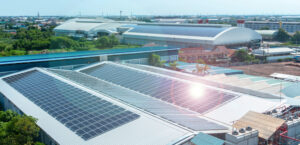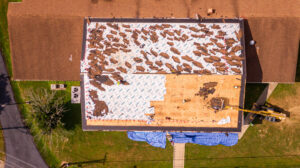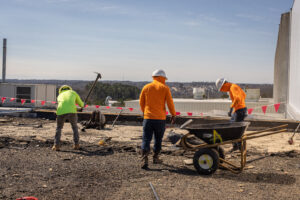In the world of commercial roofing, the installation process is a pivotal phase. It’s the foundation that determines how well a roof will perform, how long it will last, and how resistant it will be to issues like leaks and structural damage. At Eskola Roofing, we’ve been part of countless projects, and we’ve seen firsthand the repercussions of installation oversights. This guide is a deep dive into the most common commercial roofing installation mistakes, offering both insights into their consequences and solutions to avoid them.
Inadequate Roofing Material Selection
The Mistake: Opting for roofing materials based purely on cost-saving measures, aesthetics, or trends without considering the building’s specific needs.
The Impact: Using unsuitable materials can lead to a host of problems, from premature wear and tear to frequent repairs. It can also result in reduced energy efficiency and increased maintenance costs.
The Solution: Before selecting a roofing material, consider factors like the building’s location, the local climate, and the roof’s intended purpose. Engage with roofing experts to understand the pros and cons of each material and select the one that aligns best with the building’s requirements.
Poor Roof Deck Preparation
The Mistake: Rushing through the preparation phase and neglecting to ensure a clean, smooth, and entirely dry roof deck before installation.
The Impact: Any debris, moisture, or unevenness can compromise the roof’s adhesion, leading to potential leaks, mold growth, and even structural damage over time.
The Solution: Dedicate ample time to roof deck preparation. Clean it thoroughly, repair any damages, ensure it’s dry, and use a suitable underlayment to provide an additional protective layer.
Ignoring Manufacturer's Instructions
The Mistake: Bypassing or skimming through the manufacturer’s detailed installation guidelines.
The Impact: Deviating from the manufacturer’s recommendations can not only compromise the roof’s integrity but also void any warranties associated with the roofing material.
The Solution: Always have the manufacturer’s guidelines on hand during installation. Ensure that every team member is familiar with them and follows them to the letter.
Inadequate Roof Ventilation
The Mistake: Overlooking the importance of a balanced ventilation system for the roof.
The Impact: Poor ventilation can trap heat and moisture in the attic space, leading to issues like mold growth, wood rot, and a decrease in energy efficiency.
The Solution: Design a ventilation system that allows for consistent airflow. This often means having both intake vents (like soffit vents) and exhaust vents (like ridge vents) to maintain a balanced air circulation.
Incorrect Flashing Installation
The Mistake: Flashing, the material used to direct water away from critical areas of the roof, is often improperly installed or, worse, forgotten altogether.
The Impact: Poorly installed flashing is a primary culprit for roof leaks, especially around chimneys, vents, and roof intersections.
The Solution: Ensure that flashing is correctly measured, cut, and sealed. Regularly inspect these areas, especially after severe weather, to ensure the flashing remains intact.
Using Mismatched Materials
The Mistake: Combining materials that aren’t chemically compatible.
The Impact: When certain materials come into contact, they can react adversely, leading to faster degradation or corrosion.
The Solution: Research material compatibility or consult with suppliers before combining different roofing materials, especially during repairs or renovations.
Over- or Under-Tightening Fasteners
The Mistake: Not giving due importance to the torque applied to roofing fasteners.
The Impact: Fasteners that are too tight can strip the material, while those too loose can leave the roof vulnerable to wind damage or leaks.
The Solution: Use tools that can be calibrated for specific torque levels. Regularly train installation teams on the importance of correct fastener installation.
Neglecting Proper Water Drainage
The Mistake: Failing to ensure the roof has a slight slope or gradient to facilitate water runoff.
The Impact: Water pooling or ponding can accelerate the wear of roofing materials and increase the risk of leaks.
The Solution: Always design commercial roofs with water drainage in mind. Incorporate slight slopes, and ensure gutters, downspouts, and drains are regularly cleaned and maintained.
Overlapping Seams Incorrectly
The Mistake: Not paying attention to the direction and seal of overlapping roofing material seams.
The Impact: Water can easily penetrate incorrectly overlapped seams, leading to leaks and potential water damage inside the building.
The Solution: Always overlap seams in the direction of water runoff. Use quality sealants and ensure seams are pressed and sealed securely.
Not Planning for Expansion and Contraction
The Mistake: Overlooking the natural expansion and contraction of roofing materials due to daily and seasonal temperature fluctuations.
The Impact: Materials that can’t expand or contract freely might buckle, warp, or crack, leading to vulnerabilities in the roofing system.
The Solution: Allow for slight movement in roofing materials, especially in regions with significant temperature variations. Expansion joints and other architectural considerations can help accommodate this movement.
A commercial roof is a significant investment, and its installation is not something to be taken lightly. By being aware of these common pitfalls and understanding how to navigate them, building owners and contractors can ensure a roofing system that not only looks good but performs optimally for years to come. At Eskola Roofing, our commitment to excellence and attention to detail ensures that every project we undertake stands as a testament to quality craftsmanship.






